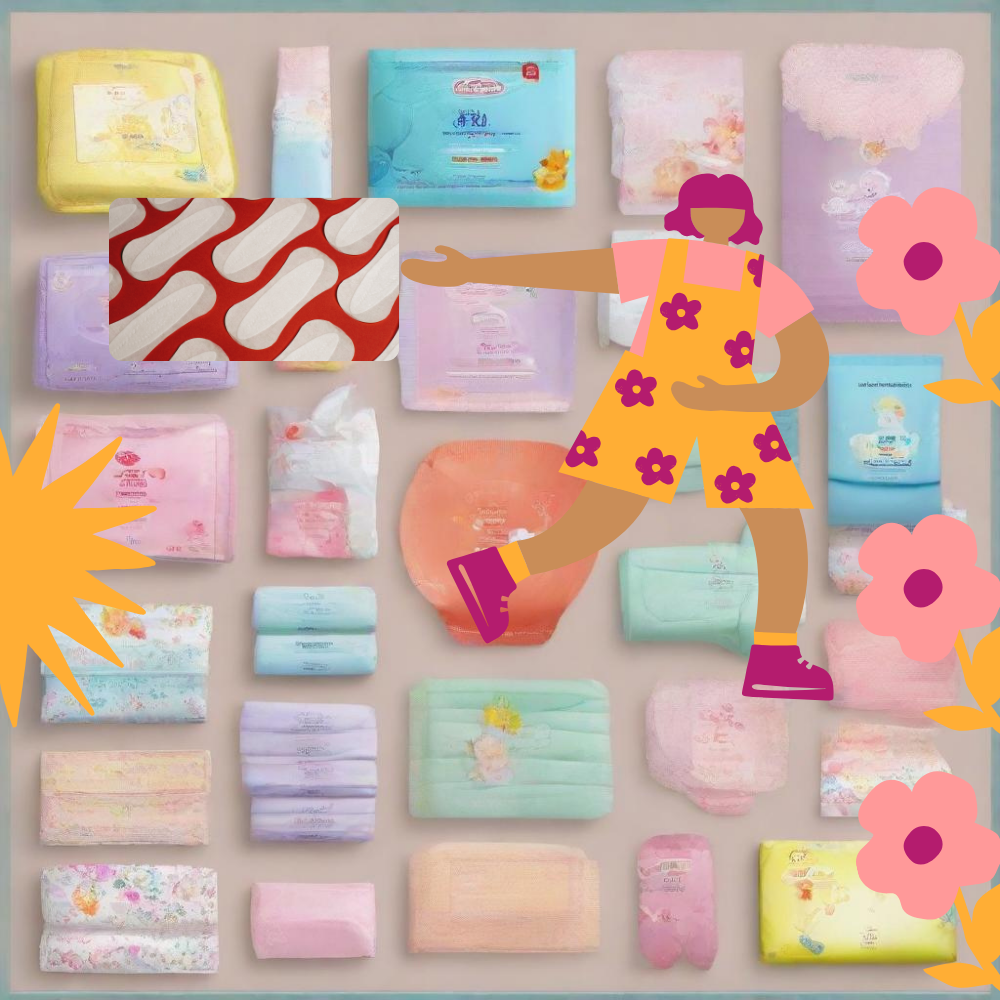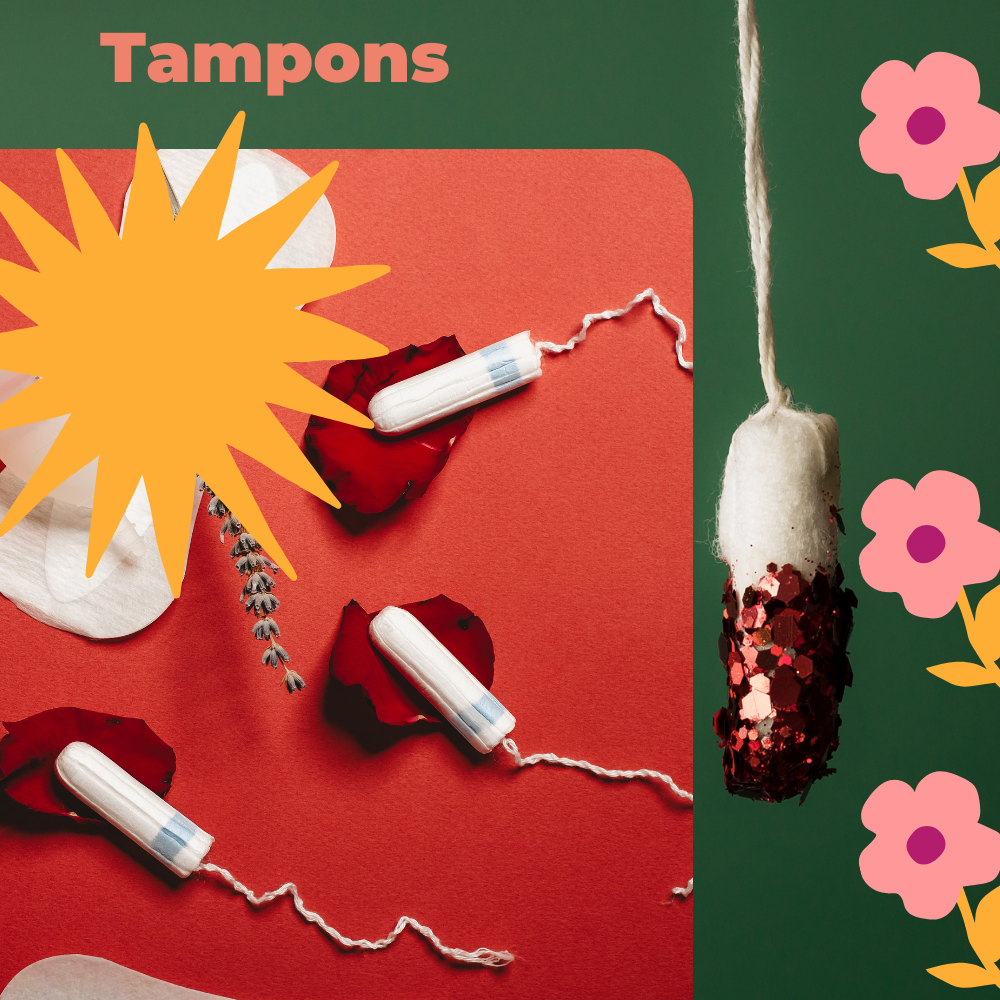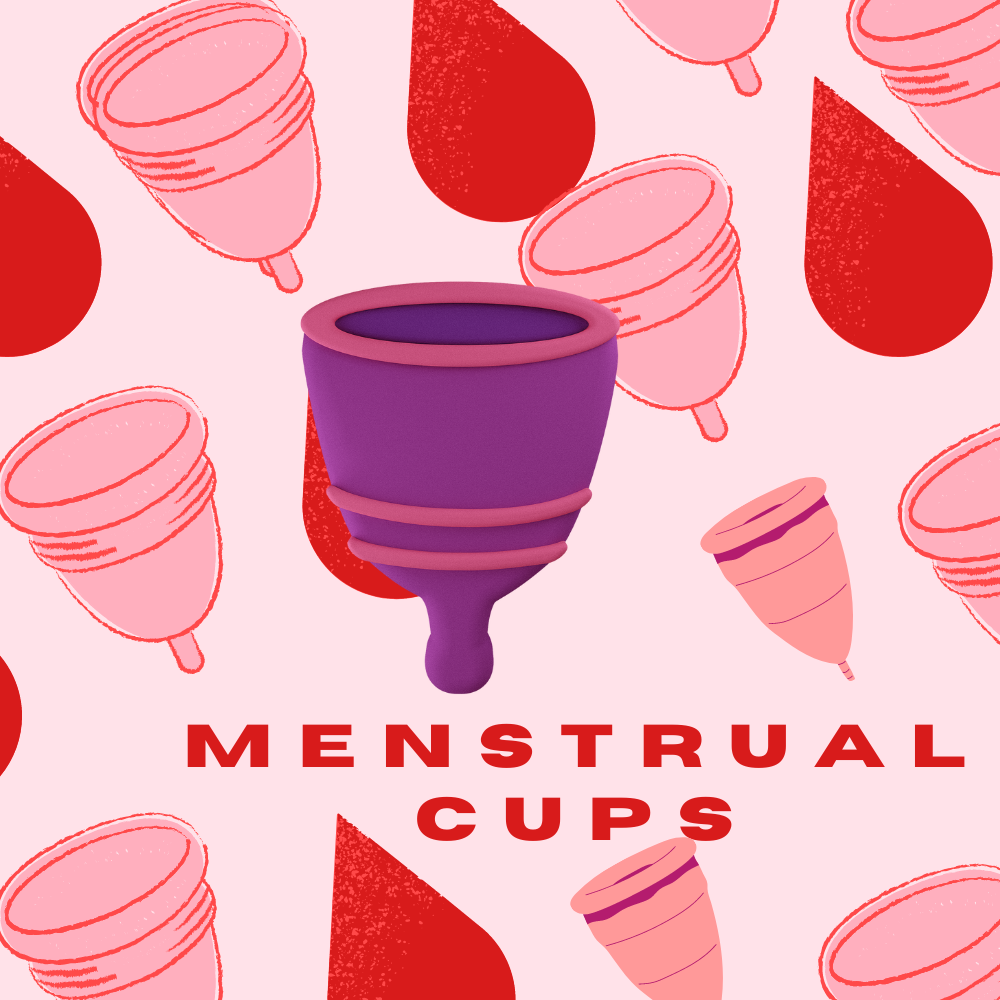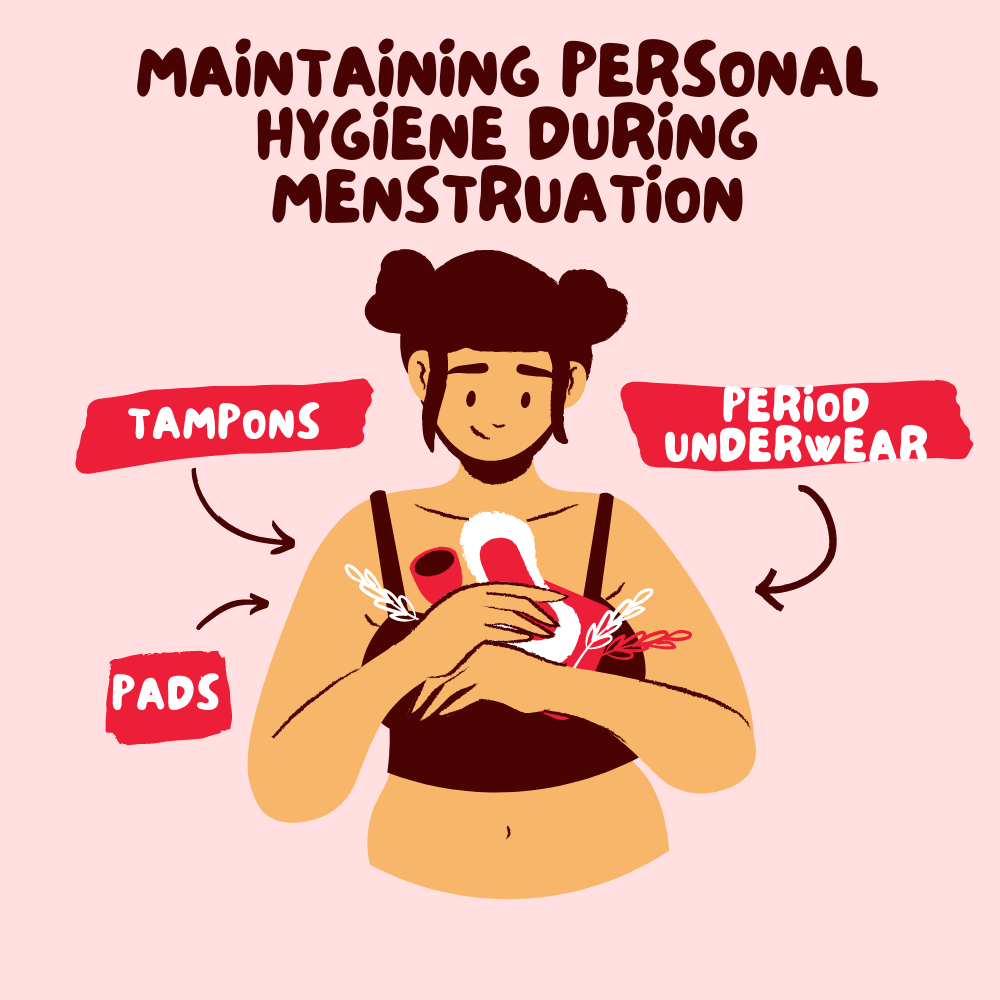Managing Menstrual Hygiene: Best Practices and Guidance
Managing menstrual hygiene is essential for health, comfort, and overall well-being. Here’s a comprehensive guide to help you understand best practices and provide guidance on managing menstrual hygiene effectively.
Understanding Menstrual Hygiene
Menstrual hygiene refers to the practices and methods used to maintain cleanliness and health during menstruation. Proper menstrual hygiene management (MHM) involves using appropriate menstrual products, maintaining personal hygiene, and ensuring safe disposal of menstrual waste.
Best Practices for Menstrual Hygiene
1. Choosing the Right Menstrual Products

Selecting the right menstrual product is crucial for effective menstrual hygiene management. Here’s an in-depth look at the different options available, their pros and cons, and guidance on how to choose the best product for your needs.
a. Sanitary Pads

Types:
- Disposable Pads: Single-use pads that are discarded after use.
- Reusable Pads: Made from washable fabric and can be reused multiple times.
Features:
- Come in various sizes (panty liners, regular, overnight) and absorbencies (light, medium, heavy).
- Have adhesive backing to stick to underwear.
- Some have wings for extra protection against leaks.
Pros:
- Easy to use and widely available.
- Suitable for individuals of all ages, including young girls and those new to menstruation.
- No risk of toxic shock syndrome (TSS).
Cons:
- Disposable pads contribute to environmental waste.
- Can cause skin irritation or rashes if not changed frequently.
- Reusable pads require regular washing and drying.
b. Tampons

Features:
- Inserted into the vagina to absorb menstrual flow.
- Available in various absorbencies (light, regular, super, super plus).
- Can come with or without an applicator for insertion.
Pros:
- Discreet and convenient for active lifestyles and sports.
- Can be worn while swimming.
- Generally provide better protection against leaks compared to pads.
Cons:
- Must be changed every 4-8 hours to prevent TSS.
- Insertion can be challenging for beginners.
- Potential for vaginal dryness or irritation in some users.
c. Menstrual Cups

Features:
- Reusable and made from medical-grade silicone, rubber, or plastic.
- Inserted into the vagina to collect menstrual flow.
- Can hold more fluid than tampons or pads, reducing the frequency of changes.
Pros:
- Eco-friendly and cost-effective over time.
- Can be worn for up to 12 hours.
- Less risk of TSS compared to tampons.
Cons:
- Insertion and removal can require practice and may be messy.
- Not suitable for everyone, especially those uncomfortable with internal products.
- Requires regular cleaning and sterilization.
d. Menstrual Discs
Features:
- Similar to menstrual cups but are flatter and fit differently.
- Positioned at the base of the cervix to collect menstrual fluid.
- Can be worn during intercourse.
Pros:
- Can be worn for up to 12 hours.
- Less noticeable for some users compared to menstrual cups.
- Can be worn during sexual activity without discomfort.
Cons:
- Insertion and removal can be tricky and messy.
- Not as widely available as other menstrual products.
- Requires cleaning for reusable discs.
e. Period Panties

Features:
- Built-in absorbent layers designed to replace or supplement other menstrual products.
- Reusable and washable.
- Available in different styles and absorbencies.
Pros:
- Convenient and comfortable, especially for overnight use.
- Reduces the need for additional products.
- Eco-friendly and cost-effective over time.
Cons:
- Initial cost can be higher than other products.
- Requires regular washing.
- May not provide sufficient protection for heavy flow days without supplementation.
f. Cloth Pads
Features:
- Made from layers of absorbent fabric.
- Reusable and eco-friendly.
- Available in various sizes and absorbencies.
Pros:
- Reduces environmental impact compared to disposable pads.
- Cost-effective over time.
- Gentle on the skin and less likely to cause irritation.
Cons:
- Requires regular washing and drying.
- Can be bulky compared to disposable pads.
- May not be as convenient for travel or active lifestyles.
Tips for Choosing the Right Menstrual Product
- Assess Your Flow: Choose products based on the heaviness of your menstrual flow. You might need different products for different days of your period.
- Consider Your Lifestyle: If you’re very active or often on the go, tampons, menstrual cups, or discs might be more convenient. For those who prefer a non-internal option, pads or period panties may be better.
- Comfort and Convenience: Select products that you find comfortable and easy to use. It may take some experimentation to find what works best for you.
- Environmental Impact: If you are environmentally conscious, consider reusable products like menstrual cups, cloth pads, and period panties.
- Cost: Reusable products have a higher upfront cost but can save money over time. Disposable products require ongoing purchase but might be more convenient for some users.
- Health Considerations: If you have allergies or sensitive skin, choose hypoallergenic products. Be aware of the risks of TSS with tampons and change them regularly.
2. Maintaining Personal Hygiene During Menstruation

Proper personal hygiene is essential during menstruation to prevent infections and ensure comfort. Here’s a detailed guide on maintaining hygiene effectively during your period.
a. Regularly Change Menstrual Products
Regularly changing menstrual products helps prevent infections, odors, and leaks. Here are the recommended practices for different products:
Sanitary Pads and Tampons:
- Change Every 4-8 Hours: Change sanitary pads and tampons every 4-8 hours, depending on your flow. Frequent changes are crucial to prevent bacterial growth and odors.
- Night Use: Consider using higher absorbency products or special overnight pads to ensure protection throughout the night.
Menstrual Cups:
- Empty Every 8-12 Hours: Menstrual cups can typically be worn for up to 12 hours, depending on your flow. Empty, rinse, and reinsert the cup at least twice a day.
- Sterilization: Sterilize your menstrual cup by boiling it in water at the end of each menstrual cycle to maintain hygiene.
Period Panties and Cloth Pads:
- Change Every 4-6 Hours: Change period panties and cloth pads as needed, typically every 4-6 hours, depending on your flow.
- Washing: Rinse used cloth pads and period panties in cold water immediately after use to prevent staining, and then wash them thoroughly with mild detergent.
b. Cleanse the Genital Area
Maintaining cleanliness of the genital area is crucial to prevent infections and ensure comfort:
Daily Washing:
- Wash Twice a Day: Wash the genital area with mild, unscented soap and water at least twice a day. This helps remove sweat, menstrual blood, and bacteria.
- Avoid Scented Products: Avoid using scented soaps, sprays, or douches as they can disrupt the natural pH balance and cause irritation or infections.
Proper Technique:
- Gentle Cleansing: Use a gentle hand to cleanse the external genital area. Avoid scrubbing or using harsh materials.
- Front to Back: Always wipe from front to back after using the toilet to prevent the spread of bacteria from the anus to the vagina.
c. Hand Hygiene
Good hand hygiene is crucial before and after handling menstrual products to prevent the spread of bacteria and infections:
Washing Hands:
- Before Handling Products: Wash your hands thoroughly with soap and water before inserting or changing menstrual products.
- After Handling Products: Wash your hands again after handling used products to maintain cleanliness and prevent the spread of bacteria.
d. Safe Disposal
Proper disposal of used menstrual products is essential to maintain hygiene and environmental cleanliness:
Disposal of Disposable Products:
- Wrap and Discard: Wrap used sanitary pads, tampons, and other disposable products in toilet paper or disposal bags before discarding them in a bin. This helps contain any odors and prevents the spread of bacteria.
- Use Sanitary Bins: Use designated sanitary bins in public restrooms when available.
Environmental Considerations:
- Biodegradable Products: Consider using biodegradable or eco-friendly menstrual products to reduce environmental impact.
- Recycling Programs: Look into recycling programs for menstrual products if available in your area.
Additional Tips for Maintaining Menstrual Hygiene
- Wear Breathable Underwear:
- Choose cotton or other breathable fabrics to allow air circulation and reduce moisture buildup, which can lead to infections.
- Stay Hydrated:
- Drink plenty of water to stay hydrated and help your body flush out toxins.
- Balanced Diet:
- Maintain a balanced diet rich in fruits, vegetables, and whole grains to support overall health and well-being during menstruation.
- Monitor Your Health:
- Pay attention to any signs of infection, such as unusual discharge, foul odor, itching, or irritation. Seek medical advice if you experience any of these symptoms.
Guidance for Menstrual Health:
1. Educate Yourself and Others
Understanding Menstrual Health:
- Menstrual Cycle Phases:
- Menstrual Phase (Days 1-5): Shedding of the uterine lining; average bleeding lasts 3-7 days.
- Follicular Phase (Days 1-13): Overlaps with menstruation; the body prepares an egg for ovulation. Estrogen levels rise, thickening the uterine lining.
- Ovulation (Day 14): Release of an egg from the ovary; peak fertility period.
- Luteal Phase (Days 15-28): Post-ovulation; progesterone levels rise to prepare the uterus for a potential pregnancy. If no pregnancy occurs, hormone levels drop, leading to menstruation.
- Hormonal Fluctuations: Estrogen and progesterone levels vary throughout the cycle, affecting mood, energy, and physical symptoms.
- Common Symptoms: Cramps, bloating, breast tenderness, mood swings, acne, and fatigue are typical. Understanding these can help manage and anticipate changes.
Educating Others:
- Open Conversations: Normalize discussions about menstruation to reduce stigma and misinformation.
- Educational Resources:
- Books: Titles like “The Period Book” by Karen Gravelle and “Celebrate Your Body” by Sonya Renee Taylor provide excellent information.
- Websites: Platforms like Planned Parenthood and Healthline offer reliable information on menstrual health.
- Workshops and Seminars: Host or attend events focused on menstrual health education, targeting schools, community centers, and workplaces.
2. Prepare Ahead
Stocking Up:
- Menstrual Products: Keep a variety of products like pads, tampons, menstrual cups, and period panties at home and in your bag.
- Pain Relief: Have over-the-counter pain relievers like ibuprofen, acetaminophen, or naproxen on hand.
- Hygiene Supplies: Carry personal wipes, hand sanitizer, and spare underwear to handle any leaks or accidents.
Travel Preparation:
- Travel Kit: Pack enough menstrual products for your trip duration, plus a few extras for emergencies.
- Emergency Supplies: Keep a small emergency kit in places you frequent, like your car, office, or gym bag.
3. Track Your Cycle
Tracking Methods:
- Menstrual Calendar: Mark the start and end dates of your period on a calendar.
- Mobile Apps: Apps like Clue, Flo, and Period Tracker offer features to log cycle dates, symptoms, and predict future periods.
Benefits of Tracking:
- Anticipate Periods: Helps avoid surprises and plan activities accordingly.
- Identify Patterns: Detect patterns in symptoms and flow, aiding in better management.
- Health Monitoring: Spot irregularities that may need medical attention, such as missed periods or unusually heavy bleeding.
4. Manage Pain and Discomfort
Pain Relief:
- Medications: Take NSAIDs like ibuprofen (Advil, Motrin) or naproxen (Aleve) to reduce inflammation and pain. Acetaminophen (Tylenol) can also relieve pain but doesn’t reduce inflammation.
- Heat Therapy: Apply a heating pad, heat wrap, or hot water bottle to your lower abdomen. Heat can help relax the muscles and alleviate cramps.
Lifestyle Adjustments:
- Exercise: Engage in regular physical activity, which can help improve circulation and reduce menstrual pain. Activities like walking, swimming, and yoga are beneficial.
- Diet:
- Nutrient-Rich Foods: Eat foods rich in iron (spinach, lentils), magnesium (nuts, seeds), and omega-3 fatty acids (salmon, flaxseeds) to reduce symptoms.
- Avoid Caffeine and Salt: Reduce intake of caffeine, salty foods, and sugary snacks, which can exacerbate bloating and discomfort.
- Hydration: Drink plenty of water to stay hydrated, which can help reduce bloating and alleviate cramps.
Relaxation Techniques:
- Yoga and Stretching: Practice yoga poses like child’s pose, cat-cow, and gentle stretches to relieve tension and pain.
- Meditation and Deep Breathing: Use relaxation techniques such as meditation, deep breathing exercises, and progressive muscle relaxation to manage stress and improve overall well-being.
5. Seek Medical Advice When Needed
When to Consult a Healthcare Provider:
- Severe Pain: If menstrual pain is severe enough to interfere with daily activities or not relieved by over-the-counter pain relievers, seek medical advice. Conditions like endometriosis or fibroids may need to be ruled out.
- Irregular Bleeding: Consult a healthcare provider if you experience irregular periods, such as cycles shorter than 21 days or longer than 35 days, or periods that are significantly different in flow or duration.
- Heavy Bleeding: If you need to change menstrual products more frequently than every 1-2 hours or pass large blood clots, this could be a sign of menorrhagia (heavy menstrual bleeding).
- Signs of Infection: Symptoms like unusual discharge, foul odor, itching, or irritation could indicate an infection such as bacterial vaginosis or a yeast infection. Seek medical advice for proper diagnosis and treatment.
- Other Concerns: Any sudden changes in your menstrual cycle or symptoms that cause concern, such as absent periods (amenorrhea) or unexpected mid-cycle bleeding, should be discussed with a healthcare provider.
Special Considerations in Menstrual Health Management
1. Adolescent Girls
Education and Support:
- Comprehensive Education: Provide young girls with comprehensive education about menstruation, including what to expect, how to use menstrual products, and proper hygiene practices.
- Resources: Ensure access to books, online resources, and educational programs tailored for adolescents. Schools should include menstrual health in their health education curricula.
- Open Communication: Create a supportive environment where young girls feel comfortable discussing menstrual health with parents, teachers, and healthcare providers.
Product Access:
- Starter Kits: Provide menstrual starter kits containing a variety of products (pads, tampons, liners, etc.) for girls to try and find what works best for them.
- School Supplies: Ensure schools have emergency supplies of menstrual products and private, clean facilities for changing them.
Psychosocial Support:
- Peer Support Groups: Establish peer support groups where girls can share experiences and support each other.
- Counseling Services: Offer access to counseling services to help girls navigate any emotional or psychological challenges related to menstruation.
2. Low-Income Settings
Product Access and Affordability:
- Affordable Products: Promote the availability of affordable menstrual products, including subsidized or free products for those in need. Community programs can distribute menstrual products.
- Reusable Options: Encourage the use of reusable menstrual products, such as cloth pads and menstrual cups, which can be more cost-effective in the long run.
Sanitation Facilities:
- Infrastructure Improvements: Advocate for and support the development of adequate sanitation facilities in schools, workplaces, and public areas. These should include private and hygienic changing areas, clean water, and waste disposal options.
- Community Initiatives: Support community-led initiatives to build and maintain sanitation facilities.
Education and Awareness:
- Community Education: Conduct community education programs to raise awareness about menstrual health and hygiene practices. Involve local leaders and influencers to reach a wider audience.
- School Programs: Integrate menstrual health education into school curricula to ensure that both boys and girls understand the importance of menstrual health and hygiene.
Support Networks:
- NGOs and Charities: Partner with non-governmental organizations and charities that focus on menstrual health to provide products, education, and support.
- Local Manufacturing: Support local manufacturing of menstrual products to reduce costs and create jobs within the community.
3. Environmental Impact
Promoting Sustainable Products:
- Reusable Products: Encourage the use of reusable menstrual products like menstrual cups, cloth pads, and period panties. These products can significantly reduce menstrual waste.
- Biodegradable Options: Support the development and use of biodegradable menstrual products that have less environmental impact compared to conventional disposable products.
Proper Disposal Practices:
- Education on Disposal: Educate users on the proper disposal of disposable menstrual products to minimize environmental pollution. This includes wrapping used products before disposal and using designated sanitary waste bins.
- Waste Management Systems: Advocate for improved waste management systems that can handle menstrual waste effectively. This may include incinerators or special waste disposal services in community sanitation facilities.
Reducing Plastic Use:
- Plastic-Free Products: Promote menstrual products that are free of plastics or use minimal plastic. Brands are increasingly offering pads and tampons with biodegradable packaging and applicators.
- Consumer Choices: Encourage consumers to choose products with environmentally friendly packaging and materials.
Detailed Recommendations for Each Consideration
Adolescent Girls
- Engagement Programs: Develop programs that engage parents, teachers, and healthcare providers to create a holistic support system.
- Practical Workshops: Organize workshops where girls can learn about menstruation through practical, hands-on demonstrations and discussions.
- Privacy and Dignity: Ensure that adolescent girls have access to private and dignified spaces for managing their menstruation, particularly in school settings.
Low-Income Settings
- Community-Led Solutions: Support community-led solutions that address specific local challenges related to menstrual health.
- Government Policies: Advocate for government policies that prioritize menstrual health and hygiene, including subsidies for menstrual products and improved sanitation infrastructure.
- Partnerships: Establish partnerships between government, NGOs, and private sector to create sustainable solutions for menstrual health management.
Environmental Impact
- Reusable Product Drives: Organize drives to distribute reusable menstrual products and educate users on their benefits and maintenance.
- Research and Development: Support research into new materials and technologies that can create more sustainable menstrual products.
- Corporate Responsibility: Encourage manufacturers to take corporate responsibility for the environmental impact of their products and to invest in sustainable product development.
Conclusion
Managing menstrual hygiene effectively is vital for health, comfort, and dignity. By following best practices and understanding menstrual health, individuals can lead a healthy and active life during menstruation. Education, preparation, and access to appropriate menstrual products are key to successful menstrual hygiene management.
FAQ for Managing Menstrual Hygiene: Best Practices and Guidance
1. What are the best menstrual products for beginners?
Answer: For beginners, especially young girls, sanitary pads are often recommended as they are easy to use and do not require insertion. Starting with thin pads during light flow days can help in getting used to them. As comfort and confidence increase, one can explore other options like tampons or menstrual cups.
2. How often should I change my menstrual product?
Answer: It depends on the type of product and your flow:
- Sanitary Pads: Change every 4-8 hours.
- Tampons: Change every 4-8 hours to prevent Toxic Shock Syndrome (TSS).
- Menstrual Cups: Empty and clean every 8-12 hours.
- Period Panties: Change as needed, typically every 4-6 hours.
- Cloth Pads: Change every 4-6 hours and wash after each use.
3. How do I maintain proper hygiene during menstruation?
Answer:
- Regularly Change Products: Follow the recommended changing times for your menstrual product.
- Cleanse Genital Area: Wash with mild soap and water at least twice a day. Avoid scented products that can cause irritation.
- Hand Hygiene: Always wash your hands before and after handling menstrual products.
- Safe Disposal: Wrap used sanitary pads and tampons in toilet paper or disposal bags before discarding them in a bin.
4. What should I do if I experience severe menstrual cramps?
Answer:
- Over-the-Counter Pain Relief: Use NSAIDs like ibuprofen or acetaminophen.
- Heat Therapy: Apply a heating pad or hot water bottle to your lower abdomen.
- Exercise: Light physical activities like walking or yoga can help reduce pain.
- Hydration and Diet: Stay hydrated and eat a balanced diet rich in anti-inflammatory foods.
5. How can I track my menstrual cycle?
Answer:
- Menstrual Calendar: Mark the start and end dates of your period on a physical calendar.
- Mobile Apps: Use apps like Clue, Flo, or Period Tracker to log cycle dates, symptoms, and predict future periods.
6. What should I do if my periods are irregular?
Answer:
- Track Your Cycle: Keep a detailed record of your menstrual cycle.
- Consult a Healthcare Provider: Seek medical advice if you experience irregularities such as very heavy bleeding, cycles shorter than 21 days or longer than 35 days, or missed periods.
7. What are the signs of a potential infection?
Answer:
- Unusual Discharge: Look out for discharge that is different in color, consistency, or has a strong odor.
- Foul Odor: Persistent foul smell from the genital area.
- Itching or Irritation: Itching, burning sensation, or irritation in the genital area.
- Consult a Healthcare Provider: If you notice any of these signs, seek medical attention for a proper diagnosis and treatment.
8. Are there eco-friendly menstrual product options?
Answer: Yes, there are several eco-friendly options:
- Menstrual Cups: Reusable and can last for several years.
- Cloth Pads: Reusable and washable.
- Period Panties: Built-in absorbent layers and reusable.
- Biodegradable Pads and Tampons: Made from organic and biodegradable materials.
9. How can adolescent girls be supported during their first periods?
Answer:
- Education: Provide comprehensive information about menstruation.
- Starter Kits: Give kits with various menstrual products to try.
- Open Communication: Create a supportive environment for discussing menstrual health.
- School Support: Ensure schools have supplies and private facilities.
10. What can be done to improve menstrual hygiene in low-income settings?
Answer:
- Affordable Products: Provide access to affordable or free menstrual products.
- Sanitation Facilities: Improve sanitation infrastructure to include private and clean changing areas.
- Community Education: Conduct programs to raise awareness and educate about menstrual health.
- Reusable Options: Promote reusable products to reduce costs.
11. How can the environmental impact of menstrual products be minimized?
Answer:
- Use Reusable Products: Menstrual cups, cloth pads, and period panties can significantly reduce waste.
- Proper Disposal: Educate on the proper disposal of disposable products and promote the use of biodegradable options.
- Reduce Plastic Use: Choose products with minimal or no plastic packaging and components.
12. When should I seek medical advice regarding my menstrual health?
Answer:
- Severe Pain: If menstrual pain interferes with daily activities.
- Heavy Bleeding: If you need to change products more frequently than every 1-2 hours or pass large clots.
- Irregular Cycles: If periods are too frequent, infrequent, or absent.
- Signs of Infection: If you experience unusual discharge, foul odor, or genital irritation.